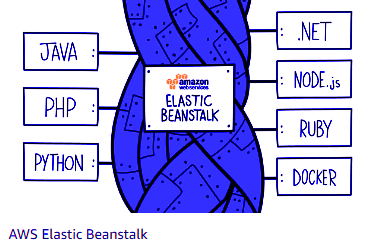AWS Elastic Beanstalk (AWS EBS) – Unique Benefits & Advantages
Free AWS Course for AWS Certified Cloud Practitioner (CLF-C01) Start Now!!
In our tutorial, we studied AWS EC2. Today, we will explore the AWS Elastic Beanstalk. In this AWS EBS tutorial, we will talk about the benefits, advantages, and disadvantages of Elastic Bean Stalk.
So, let’s start the AWS Elastic Beanstalk Tutorial.
What is AWS Elastic Beanstalk?
Elastic Beanstalk is a service provided by AWS which is used for deploying infrastructure which consists of many AWs services. These services include AWS S3, EC2, auto-scaling, cloud watch, Elastic load balancer, and simple notification service.
It is easy to start with Elastic Bean Stalk as you can see AWS Management Console, the command line interface or the API. All you have to do is choose your platforms such as Node.js or Ruby and Amazon EC2 instance type.
After the code is uploaded the AWS Elastic Beanstalk will handle the rest of the activities such as provisioning, load balancing, auto-scaling, and other activities.
AWS does not implement any extra charges for Elastic Beanstalk as you have pay only for the AWS resources needed to run your applications without any hidden or upfront cost.
Do you know What is Amazon ELB?
Benefits of Elastic Beanstalk in AWS
These are the following AWS Elastic Beanstalk benefits, let’s see them one by one:
a. Flexible and Easy to Begin
AWS made it easy to deploy the application on AWS. It can be done with the help of AWs Management Console, Visual Studio or Eclipse to upload your application. AWS EBSautomatically manages the deployment details of capacity provisioning, auto-scaling, and application health monitoring.
Within a moment your application will be ready and can be used without any resource configuration and infrastructure work on the coder’s part.
b. Scaling the Demand
Adjustable Auto scaling settings help Elastic Beanstalk to automatically scale the application. Your application can handle peaks in workload or traffic while minimizing your costs.
For an instance to trigger Auto Scaling Actions one can use CPU Utilization Metrics. It also helps you to minimize the cost while keeping the application at the peak.
c. Control Over Tools
AWS provides you the control over tools and resources such as Amazon EC2 instance type which is optimal for the application. AWS Elastic Beanstalk Management Capabilities helps us to take over the few or all the elements of the infrastructure. For, powering your application EBS allows full.
Let’s revise AWS Architecture & Components of AWS Architecture
d. Provides Productivity
AWS EBS helps you to provide security, managing and configuring servers, managing database, load balancers, firewalls, and networks.
This benefits a lot as one can focus only on building code rather than performing other actions. EBS supervises and operates the infrastructure and manages the application. It saves time from development and expertise.
Customers of Amazon Elastic Bean Stalk
- Zillow
- Prezi
- BMW
- Jelly Button Games
- Speed League of Women Voters
- GeoNet
- Ivi Data Group and many more
Advantages of AWS Elastic Beanstalk
Let’s learn the advantages of AWS EBS:
- AWS Elastic Beanstalk provides a cost-effective price in which you only have to pay for what you use and there are no hidden costs.
- Amazon Elastic BeanStalk builds the setup and configures. Moreover, it spectators the AWS services such as EC2, Elastic Load Balancers, RDS to create Web Services.
- Fast access is provided such that you can access the AWS management console in less than one hour.
- EBS creates a fairly standard configuration for modern railway applications.
- AWS Elastic Beanstalk supports Java, .NET, PHP, Node.js, Python, Ruby, Go, and many more web applications.
- SQL Server is configured through Amazon RDS but there is an EC2 server behind with a database running on it.
Disadvantages of AWS Elastic Beanstalk
After learning advantages, let’s cover the disadvantages of AWS EBS:
- Many times it happens that there is a failure in deployment. When the deployment fails there is no notification and further deployments fail as well.
- Solutions such as terminating the instance that had deployment issue and recovering elastic beanstalk won’t work.
- If the machine recovers then also we won’t be able to find the fault. This left us in a state of confusion whether the machine is healthy or not.
- Sometimes deployment is slow as it takes a minimum of 5 minutes and a maximum of 15 minutes just for two front-end servers.
- AWS Elastic Beanstalk comes with a new stack update but fails to inform that what’s new.
Follow this link to know about AWS Advantages & Disadvantages
So, this was all about AWS Elastic Beanstalk Tutorial. Hope you like our explanation.
Conclusion
Hence, in this AWS EBS Tutorial, we studied Elastic Beanstalk helps us to easily manage the infrastructure of the AWS. EBS offers fine-grain control which helps us to choose between different technologies that are most helpful for us.
Automation feature of EBS helps us to deploy applications with an ease. Containers like Docker help to enhance the deployment process. If one wants to reduce system operations focus on developing codes without worrying about other issues AWS Elastic Bean Stalk is a good choice.
Still, if you have any query, feel free to ask in the comment box.
We work very hard to provide you quality material
Could you take 15 seconds and share your happy experience on Google






